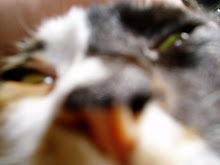This year is the 20th anniversary of
THE BOOM, being famous for their song "
Shima Uta 島唄 *". The band which consists of 3 persons (
Kazufumi Miyazawa 宮沢和史, Takashi Kobayashi 小林孝至 and Hiromasa Yamakawa 山川浩正) from Kōfu and a person (Takao Tochigi 栃木孝夫) from Chiba Pref, was set up in November 1986. They started up their performance at Hokoten ホコ天 (pedestrian zone),
Harajuku 原宿 in the following year and came out with the single "
Kimi wa TV-kko 君はTVっ子" & the album "
A Peacetime Boom" in 1989. "
JAPANESKA" in which "
Shima Uta" is included was released in 1990. From that time, THE BOOM's music was changing its style and sound, absorbing ska, Brazilian music,
Okinawa's sound and so on. They had suspended their activities from 2006, but have taken them up again since 2008.
There are some lyrics associated with their home, Yamanashi, in their songs.
・On "
Soko ga Boku no Furusato (That is my home town) そこが僕のふるさと", included in their 9th original album "
LOVIBE" (released in 2000), Mt.Atago 愛宕山 in Kōfu appears. They sing, 'Let's get (friends) together to climb' the mountain.
・In "
Hoshi no Love Letter (Love letter of stars) 星のラブレター", they sing, 'In Asahi street at evening the familiar stray dogs sometimes used to tell me something about you that I didn't know.' Kazufumi Miyazawa, main vocals of the band, said in an interview** that he had bought his guitar in fifth grade in elementary school at a shop in Asahi street*** and the girl who he had loved had lived there.
・"
Chūōsen 中央線"(refer to
Chūō Line) whose lyrics are wistful and painful is one of my most favorite songs and has been covered by various artists (
Akiko Yano 矢野顕子,
Izumi Katō 加藤いづみ and so on).
■You can listen to the samples(only of "
The Boom Collection 1989-2009 ") or buy the CDs from the below links.
LOVIBEincluding "
Soko ga Boku no Furusato そこが僕のふるさと"
■
THE BOOM's official web site (Japanese version only, but you can read only the articles about Miyazawa in English or Portuguese)
* The song was hit in Argentina in 2001, sung by
Alfredo Casero ** The program "Utti na Mokuyōbi ウッティ(UTY)な木曜日" in which the interview was included was put on the air in March 2008.
*** I introduced the spot on "
Wagashi." You can know the location of the shop on the below map.
View
Mt. Atago 愛宕山 & Musical instrument shop in Asahi Street 朝日通り on Google My Maps































